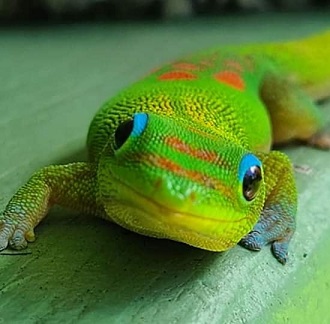 |
| Sphaerodactylus elegans of Cuba |
Geckos are some of the most diverse and widespread squamates on Earth. They range in size from the dwarf
Sphaerodacylus of the Antilles (16-18 mm) to the (probably) extinct Kawekaweau or Delcourt's Giant Gecko,
Hoplodactylus delcourti, of New Zealand (as long as a
tuatara and as thick as a man's wrist). Except for a few species, none have eyelids, and most have adhesive pads on their toes that allow them to climb slick surfaces. Some are parthenogenic. A few owe their success partly to humans, and it is these that we consider here today.
Several species of gecko have been introduced to the United States by humans, most accidentally, as stowaways or through the pet and greenhouse trade. One of the most ubiquitous is the Mediterranean House Gecko,
Hemidactylus turcicus. Described by Linnaeus in the first edition of his
Systema Naturae, it is a yellow-tan, nocturnal, insectivorous gecko about six inches long. Whereas most of our non-native lizards are limited to a few small areas in Florida,
H. turcicus can be found in 17 states, from California to Maryland. It isn't continuously distributed across the southern US, but rather locally common in urban sites, due to many separate introductions, the earliest of which occurred in Key West before 1915. One such population is in a middle school in Cary, North Carolina.
 |
| Hemidactylus turcicus |
Legend has it that a science teacher during the early 1980s was keeping some H. turcicus in a terrarium. All was well until an absentminded student left the lid off one day. The lizards escaped, and a small population has been living in the walls of the school campus ever since. At least, that's what everyone thought. An ongoing summer of research conducted by a wildlife student at North Carolina State University, my brother Kevin Durso, in 2012, has revealed that the population is much larger than anyone thought.
 |
| Bags of geckos |
On the first night, Kevin counted 82 geckos on the walls of the campus buildings. He came back with reinforcements - tall college students and volunteers armed with lizard nooses and water guns, for blasting geckos off ceilings and walls. On some nights, students at the middle school come out with their teachers and parents to see what the research is all about. Kevin & Co. are marking each gecko they capture with glow-in-the-dark elastomer, so they can be individually identified upon later capture. Once captures of new, unmarked geckos begin to decline, he can begin to estimate the total size of the population using a mathematical model. Whether this will happen sooner or later is still hard to know. Kevin is also keeping track of the exact location of each gecko sighting, so that a home range size estimate can be made. He works at night, when the geckos are most active. Perhaps this is why no one knew the true size of the gecko population until now - how often is anyone at school at night? Not if I can help it, Mom!
 |
| Super Soaking a gecko off a wall |
Previous research on house geckos has revealed that they inhabit similar areas, both climatically and in terms of microhabitat, in their native and non-native range. A population on the Stephen F. Austin State University campus in Nacogdoches, Texas, ate mostly grasshoppers, moths, and isopods. Their great success in southern North America has been attributed to low predation pressure, little interspecific competition, and a life history which maximizes survival at all ages. House geckos in southern Louisiana are host to native North American parasitic worms, so there is some potential for parasites to regulate populations of these non-native lizards.
 |
| Injecting a gecko with glow-in-the-dark elastomer |
What factors have allowed the Cary
H. turcicus population to grow so large? What effects do these non-native geckos have on the local ecosystem, from the arthropods they eat to the birds and snakes they are eaten by? Have they been spreading around the Triangle area since the 1980s, brought home on schoolbuses in students' backpacks and coats? Only time, and further research, will tell.
gecko,geckos,invasive species,reptile










